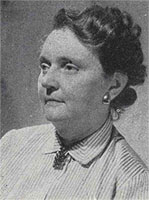
 Suzanne Guiguichon was born in Paris on September 1, 1901. From 1921 to 1929, she was a student at the School of the rue Madame, where Maurice Dufrène was a professor, and during that time, she worked as a draftsman at the ''Maîtrise" he directed. In 1930, she started her own business and began participating in various exhibitions, including the Salon des Artistes Décorateurs, Salon d'Automne, Salons des Arts Ménagers, and decorative art events abroad.
Suzanne Guiguichon was born in Paris on September 1, 1901. From 1921 to 1929, she was a student at the School of the rue Madame, where Maurice Dufrène was a professor, and during that time, she worked as a draftsman at the ''Maîtrise" he directed. In 1930, she started her own business and began participating in various exhibitions, including the Salon des Artistes Décorateurs, Salon d'Automne, Salons des Arts Ménagers, and decorative art events abroad.
Throughout her career, she received plaques and diplomas, such as a gold medal at the 1925 Exposition des Arts Décoratifs and the Grand Prix d'Honneur at the 1937 International Exhibition. She was awarded the gold plaque from the Society of Encouragement for Art and Industry, as well as prizes for wickerwork and from the hoteliers' union at the Salon des Décorateurs in 1953.
In addition to designing and executing numerous private installations, she received commissions from the State, including the dining room of the Ministry of Agriculture and a boudoir for an embassy. She also worked on the Mayor's office in the 6th arrondissement, M. Paul Auriol's bedroom at the Château de Rambouillet, and created prototypes of student rooms for the Cité Universitaire, Pavilions for Engineers of Arts and Crafts, and Morocco.
For 15 years, she has been a professor at the School of the rue de Seine (formerly the School of the rue Madame) and since 1953, at the technical college of the rue Duperré. She is also in charge of a program at the National School of Decorative Arts. Suzanne Guiguichon was a member of several committees at the 1937 Exhibition, served on the board and committee of S.A.D. for several years, and is currently a member of the board of U.A.D.C.E. (with Beucher as President) and the National Commission of the Ministry of Labor, among others.
Suzanne Guiguichon brings a distinctly feminine touch to her decorative designs. She is practical and strives to find pleasant and elegant solutions to daily problems, whether it's organizing and furnishing a unique room, cleverly arranging furniture, bars, cabinets, secretaries, and wall-mounted fireplaces, or simply inventing small furniture pieces like cup holders, book or magazine stands, and seat shelves that contribute to comfort and enjoyment for users.
Alongside these functional refinements, Suzanne Guiguichon carefully composes and studies furniture, which she continues to have crafted by the artisans of her mentor, Maurice Dufrène. She prefers light woods, particularly sycamore, but also appreciates the contrast or combination with certain dark woods, such as pear wood, which serve as decoration.
In her interior compositions, Suzanne Guiguichon favors wall-mounted furniture over isolated pieces, but in some cases, she tastefully and playfully incorporates lightweight elements like wicker or finely lacquered metal tubes: charming aviaries placed in the midst of small cactus or flower gardens.
She employs various means to create a harmonious ambiance, designing fabric patterns, carpets, table centerpieces, ceramics, lamps, and lighting fixtures, in short, all familiar objects, and entrusting their execution to specialized artisans.
Sources : Mobilier et Decoration N° 4 Mai 1954